3 Quick Cures for Q4 Returns Hangover

You did it! Your had your best Q4 to date. Your team found the perfect items. The marketing campaigns crushed it. The warehouse delivered. There may be one problem.
So when you’re navigating your retail brand through the seemingly enormous world of eCommerce, sometimes things slip through the cracks, and often times your returns policy is one of those things.
Okay— so your returns policy isn’t the most attractive thing that pops up when you think about your eCommerce business, but what if instead of being a pesky reminder that product returns still exist, your returns policy could help retain customers and even drive sales? Aha, now we’re talking, but aren’t product returns bad for business, how could they possibly help my bottom line? Two words. Customer Experience.
The Buyer’s Journey: How Your Returns Policy Translates Into A Lifetime Customer
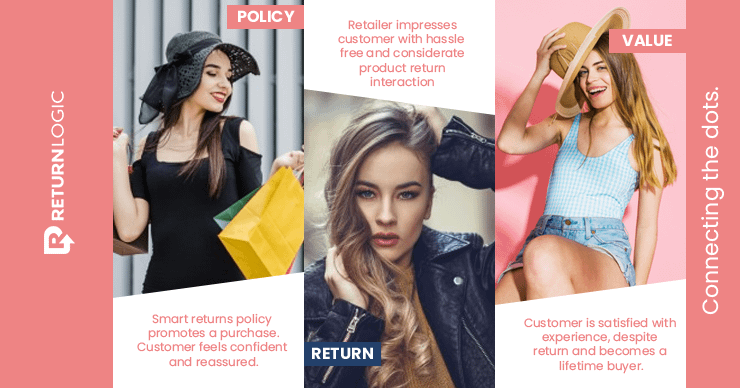 As eCommerce retailers, we understand the role that happy customers play in our business, and it’s a big one. Happy customers are not only returning customers, but they’re also promoters of your brand, completely immersed in the value your products provide to them. Your returns policy is a major factor in the buyer’s journey, and ultimately contributes to how satisfied a consumer is with your brand. Having a strong eCommerce returns policy is one of the first steps in generating a positive customer experience— if your customer can extrapolate a hassle free and trustworthy interaction with your business by looking at your returns policy, you’ve set the motion to generate a new sale. Looking at the bright side Thanks to a consumer oriented returns policy a customer previously on the fence gains some reassurance to complete an order, and one of two things happen:
As eCommerce retailers, we understand the role that happy customers play in our business, and it’s a big one. Happy customers are not only returning customers, but they’re also promoters of your brand, completely immersed in the value your products provide to them. Your returns policy is a major factor in the buyer’s journey, and ultimately contributes to how satisfied a consumer is with your brand. Having a strong eCommerce returns policy is one of the first steps in generating a positive customer experience— if your customer can extrapolate a hassle free and trustworthy interaction with your business by looking at your returns policy, you’ve set the motion to generate a new sale. Looking at the bright side Thanks to a consumer oriented returns policy a customer previously on the fence gains some reassurance to complete an order, and one of two things happen:
- The product the customer receives aligns with the customer’s needs and expectations, and the customer is satisfied with the transaction
- Something went wrong— and the product is sent back
It’s obvious that the former is the preferred result, however, it’s also no secret that product returns are a staple of doing business online. But don’t worry… even though a product return signifies a disappointed customer, we can turn this negative into a positive. By leveraging an eCommerce returns policy powered by the customer experience, each product return becomes an opportunity to impress the customer and convert them into a lifetime buyer.
If your returns policy is structured correctly, then your customer will receive a seamless product return experience that translates into an atmosphere of trust, quality, and efficiency—all major contributors of customer loyalty.
So it doesn’t matter if you’re a newcomer launching your first Shopify store, or manage a complex and vast omnichannel operation—by following this 9 step guide to optimizing your eCommerce returns policy, you’ll be able to drive in more sales, earn more lifetime customers, and improve your bottom line.
1. Think Scooby Doo, Not Sherlock
Consumers today are detail driven and collect a mountain of information before they’re ready to hand over their hard earned cash. During their research, 66% of online shoppers review a store’s returns policy before committing to a purchase. With a majority of consumers using your eCommerce returns policy to make a decision about your brand, having an easy to find and accessible returns policy becomes paramount. 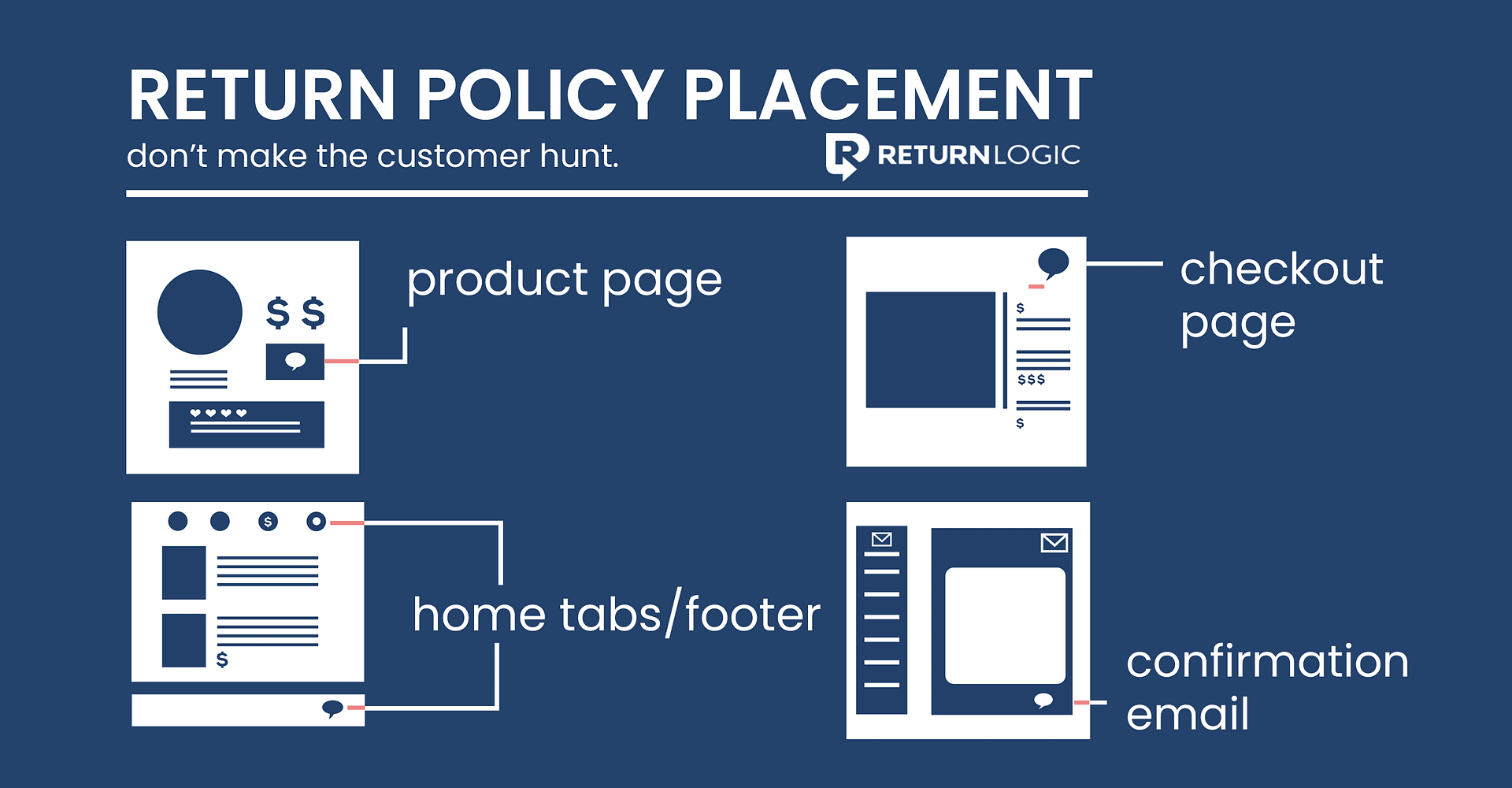 Too many online retailers shove their returns policy statement under a pile of complicated terms and conditions that are only accessible through a vague link on the footer of their site. Consumers are shopping online to save time, so you can guarantee they won’t be playing detective. To ensure your returns policy is easily accessible start by: Including a link in your website footer dedicated specifically to your returns page, but don’t stop there. Make sure to include links to your policy throughout your website. A visible returns policy will help prevent cart abandonment and reassure consumers of their purchase. Here’s where we recommend you include your returns policy for maximum visibility
Too many online retailers shove their returns policy statement under a pile of complicated terms and conditions that are only accessible through a vague link on the footer of their site. Consumers are shopping online to save time, so you can guarantee they won’t be playing detective. To ensure your returns policy is easily accessible start by: Including a link in your website footer dedicated specifically to your returns page, but don’t stop there. Make sure to include links to your policy throughout your website. A visible returns policy will help prevent cart abandonment and reassure consumers of their purchase. Here’s where we recommend you include your returns policy for maximum visibility
- On Your Product Page: This placement will help encourage the sale of a product by allowing the customer to keep the product in mind while they review your policy. Having easy access to the returns policy will persuade the consumer to make the purchase.
- On Your Home Page: Place a link to your returns policy in an accessible location on your site’s homepage, consumers are usually looking for a dedicated tab or link in the footer.
- During Checkout: It might seem counterproductive, but including a link to your eCommerce returns policy in your checkout cart will encourage the customer to take the final step. Not only will including your returns policy during the final stage of purchase help reduce cart abandonment, it will also reaffirm your brand’s integrity.
- In Your Confirmation e-Mail: Placement of your store’s return policy in the order confirmation email serves as the final reminder to the customer that your main priority is the customer’s satisfaction, and you’re willing to give them a hassle free returns experience if they’re not satisfied.
2. Watching ‘Suits’ doesn’t make you a lawyer
Often times consumers are faced with complicated legalese when reading a retailer’s policies. Consumers don’t want to exert any effort into decoding your complicated statements, so they’ll just move onto the next retailer. To make sure consumers can purchase from your store with peace of mind intact, write your returns policy with a conversational and friendly tone.
Start your policy statement off with an acknowledgment that the customer isn’t content with the product they purchased, and you’re going to rectify the situation. This preface to your policy will help illustrate to the customer that you’re on their side.
Avoid using authoritative language that commands or tells the customer what to do, you want to make the returns process as pain free as possible.
Remember to include a statement of gratitude to show the customer that you still value their business.
3. Provide Free Returns, Seriously
While there are arguments both for and against free returns shipping, the truth of the matter is customers already feel that returning a product is too much effort—stamp on the cost of shipping, and it’s no surprise why 60% of consumers won’t even consider making an online fashion purchase unless returns are free. By incorporating free returns into your policy you’re giving customers reassurance that they won’t be dealing with the extra hassle of shipping cost. Increased sales are good, but wouldn’t my return rate increase? Not necessarily. As aforementioned, including links to your returns policy on your product and checkout pages will give your brand some credibility with potential customers—which will ultimately sway them towards the purchase. Will you get some returns? Sure, but now you have the opportunity to provide an exceptional and hassle free return experience that will convert a dissatisfied customer into a lifelong purchaser.
4. Set Clear Cut Guidelines For The Return
The world is full of misunderstood text messages, we don’t need any more miscommunication in our lives.Make sure your customers fully understand the details of your returns policy so the returns process can be handled quickly and effectively. 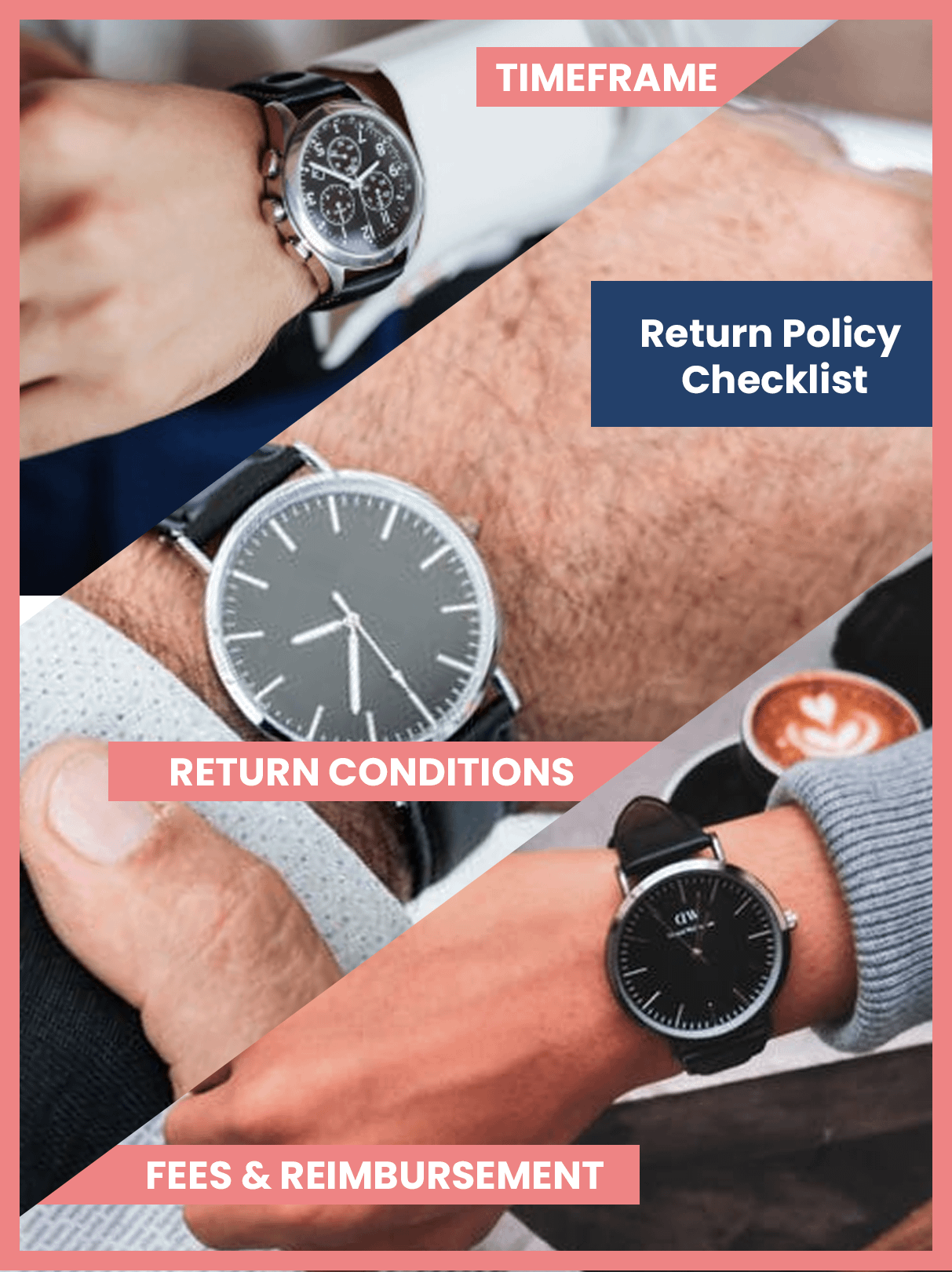 Laying out clear guidelines also sets limits to what your customers can return, and how that return must occur. Every good eCommerce returns policy is composed of the following elements:
Laying out clear guidelines also sets limits to what your customers can return, and how that return must occur. Every good eCommerce returns policy is composed of the following elements:
Time Frame: The period in which your store accepts a product return, and when the customer can expect a refund. Depending on the product itself and any seasonal events or holidays that occur, you might want to vary this interval.
Provide a clear number of days that you will allow your consumers to return a product.
Specify the number of days in which your consumers will receive the refund.
Return Conditions: Determine the terms for a valid return. There are various factors that you may need to look at including:
- Packaging of an item
- Where the item was purchased, if you’re an omnichannel retailer
- Hygiene Considerations
Reimbursement Options and Attached Fees: Address all the refund options your customers have for their product return.
- Can consumers receive store credit, or exchange an item?
- List all the attached fees for an item, and explain why they occur.
- Think carefully about any deductions and fees that are a part of the returns process, not all transactions are immediately apparent.
- Will international orders translate into different fees?
By clearly setting the boundaries for your product returns policy, you’re not only giving consumers clear expectations of your returns process, but are also protecting yourself from return fraud.
5. Create an FAQ Page for Your Returns
Some eCommerce brands have FAQ pages dedicated to their products and stories— why not apply the same methodology to explain your returns process? 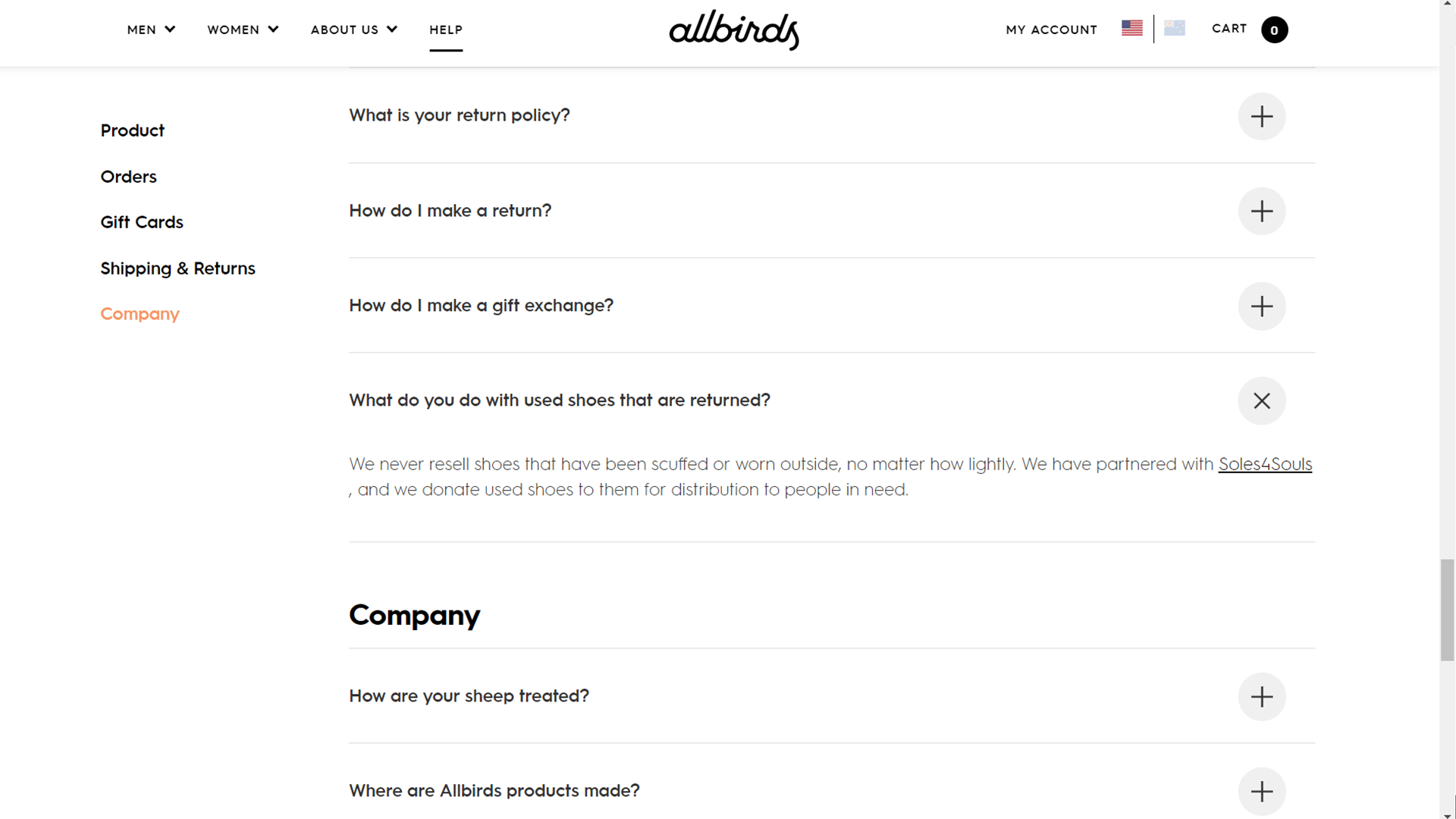 Remember, shopping online is all about time and cost savings, answers to common questions and fears about your eCommerce returns policy should be easily answered.
Remember, shopping online is all about time and cost savings, answers to common questions and fears about your eCommerce returns policy should be easily answered.
- With an FAQ section, retailers can answer questions in much more detail, which translates into an easier buyer experience.
- Retailers can be acrobatic with their product returns by answering questions in regards to specific products.
- Incorporating returns into your FAQ page can steer customers towards finding answers that might save the sale, so remember to include any help documentation, tips, and general guidelines to help consumers get the most out of the product they’ve ordered.
6. Personalize Your Returns Policy
Use your brand identity and voice to make your returns policy interesting and creative. The key idea is to separate the pain of a product return from the positive customer experience your business is trying to provide. By phasing in your company branding into a returns policy you’re allowing the customer to become comfortable with the return process, which is paramount when you consider that a vast majority of consumers will consider purchasing from a retailer again if they are happy with the returns policy. By creating a fun or memorable returns interaction, a customer will associate your brand with a good experience.
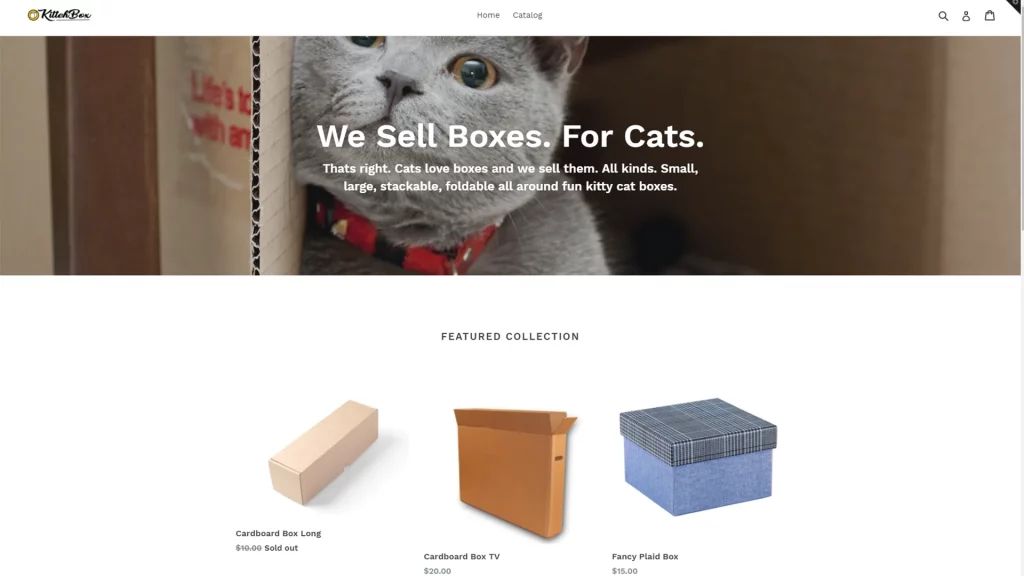
KittehBox is a business that helps customers purchase homes for their cats, a concept which is both amusing and practical. Instead of writing a traditional and mundane eCommerce returns policy, Kittehbox employs the use of their brand voice, and leverages buyer profiles to craft an eCommerce policy that speaks to consumers. 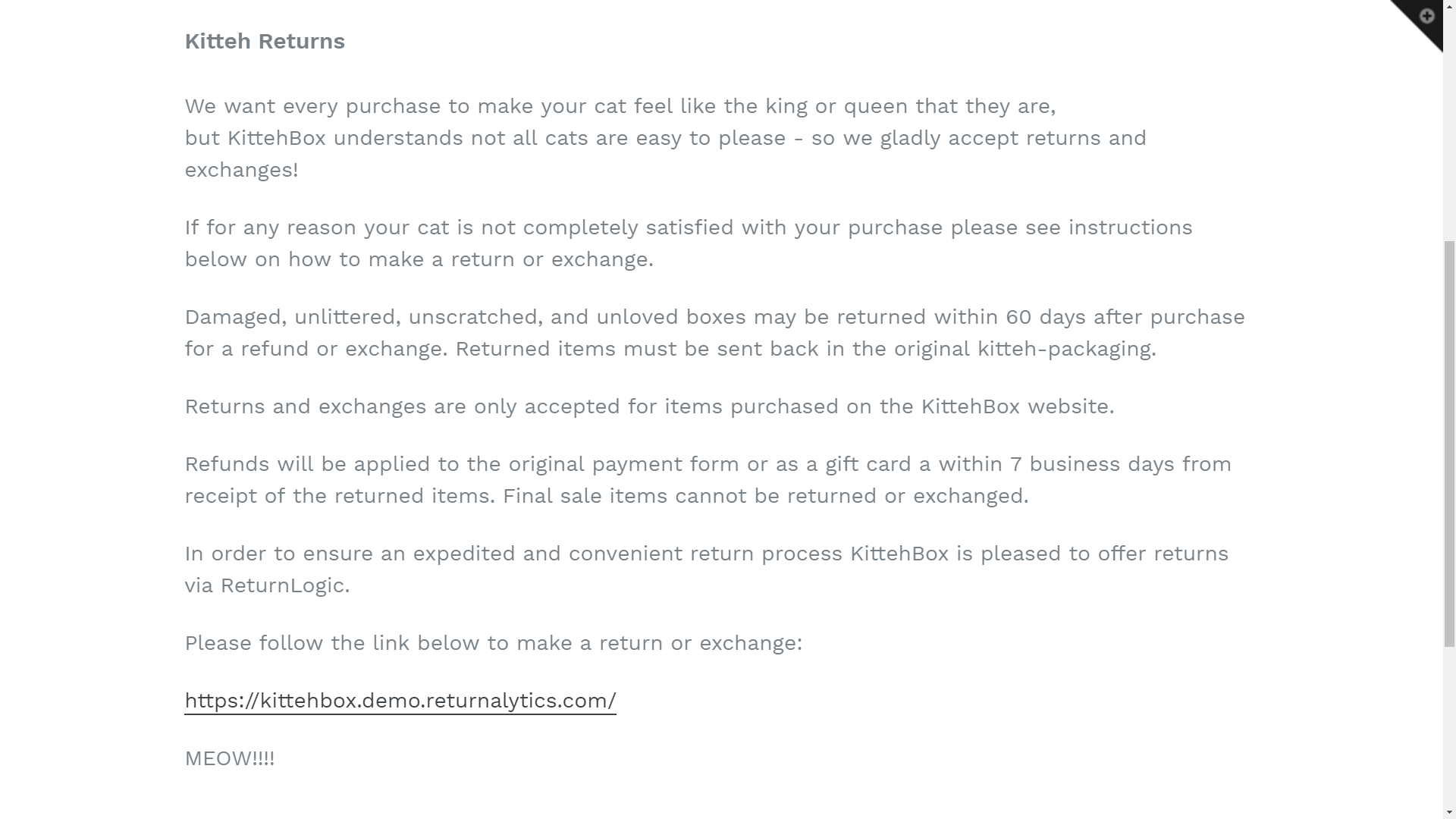
Use Graphics to Present Your Returns Policy
Retailers can present their returns policy through graphical means such as photos, infographics, and even video. By using your company branding to create a graphical returns policy you’re making the information more interesting and consumable for the customer— which factors into their decision when they think about purchasing from your store again.
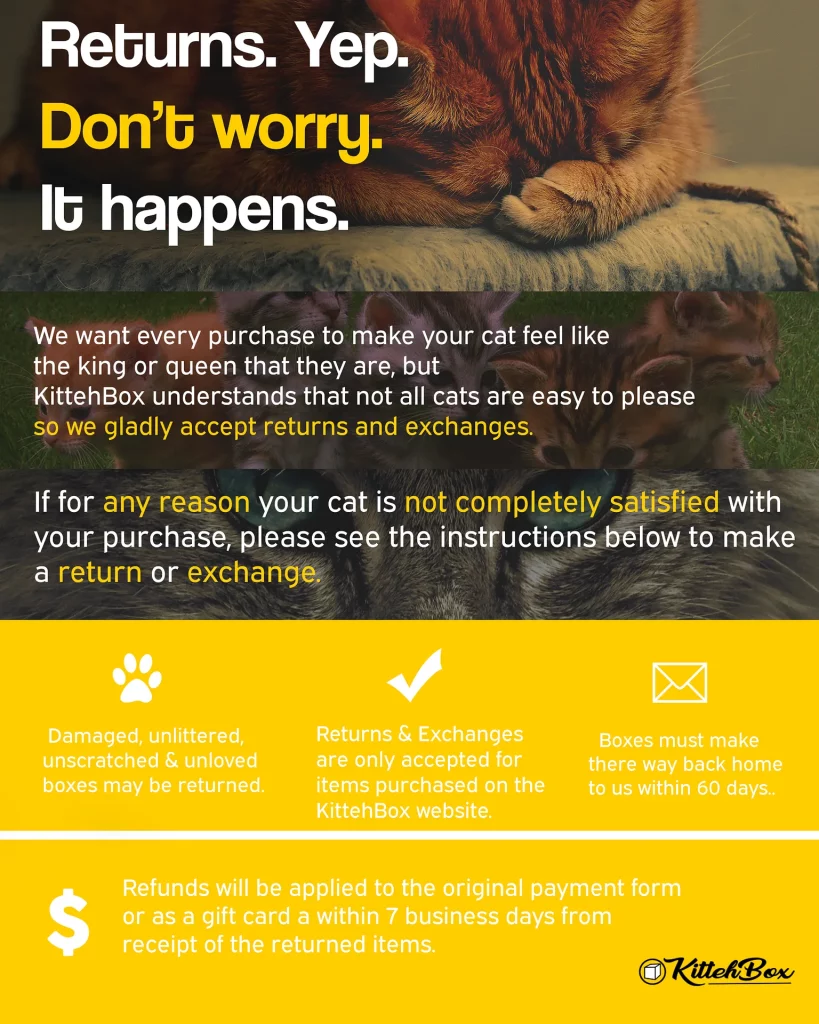
Take inspiration from how this returns policy was presented and create a custom presentation of your eCommerce returns policy to re-target your buyer personas and create an extraordinary customer experience.
7. Adopt A More Liberal Returns Policy
As aforementioned, consumers are persuaded to purchase a product if they know they can return it later— this behavior translates into an increase in product sales.
While more sales are great, retailers still need to craft a returns policy that will prevent those sales from turning into returns.
The obvious action would be to tighten up your returns policy, right? Wrong, a more lenient returns policy can actually prevent product returns.
Lengthening The Time Frame for Your Returns Policy
According to research conducted by Narayanan Janakiraman, an Assistant Professor of Marketing at the University of Texas:
- An increase in the time consumers have to return a product translates into a decrease in return rate.
- Longer return periods alleviate the pressure consumers feel when faced with a short term return deadline.
- Consumers spend more time with the product, and are subject to what researchers refer to as the “endowment effect”, which creates an attachment to the product the longer the consumer has it in their possession.
- Consumers will forget to initiate the product return over a longer period of time.
Finding the Optimal Time Frame
Many retailers opt for a standard 30 day returns policy, and while that interval provides customers with enough time to return a product, it doesn’t come with the aforementioned benefits of a truly liberal returns policy.
Retailers should take advantage of the endowment effect and consider increasing their returns window to 60 to 90 days. While there is no magic number for your returns time frame, an interval that is too generous might be counterproductive, so make sure it makes sense to provide long term returns.
8. Thank The Customer For The Return
Product returns damage the customer experience, and while providing a seamless and hassle free return interaction will get retailers back on good terms with consumers, there still is no promise of returning consumers. Retailers need to be proactive when considering the customer experience after every return.
Sending the consumer a thank you letter or email will show the customer how much you value you their business.
- Make sure to acknowledge the dissatisfaction the consumer endured.
- Subtly emphasize that you would appreciate them shopping with your store again
Not only does a thank you message show the consumer how much a retailer values their business, but it also opens up a new sales opportunity. By leveraging some data and buying trends that retailers collect about their consumers, the possibility of using incentives to reclaim a consumer arises.
Along with your thank you message, include a discount towards the consumers next purchase. Some retailers are smart about their returns collection and have return reason codes attached to an order. By looking at the reason for a return, retailers might be able to offer a smarter discount.
Let’s say Becky orders a jacket from your Shopify store, and then returns that jacket because it was too big. Using the data you’ve collected regarding Becky’s return, and your thank you message, you send Becky a 30% off coupon for a purchase of the same jacket in a different size. Along with a personalized thank you message, smart retailers will ask for something in return—feedback. Asking your consumer to answer questions about their returns experience and product will help you make smarter choices moving forward. Consumers generally gloss over answering disruptive survey questions, so by thanking a consumer for a return, they will be much more receptive to providing valuable feedback, which you can use to increase sales and reduce returns.
Key Takeaways:
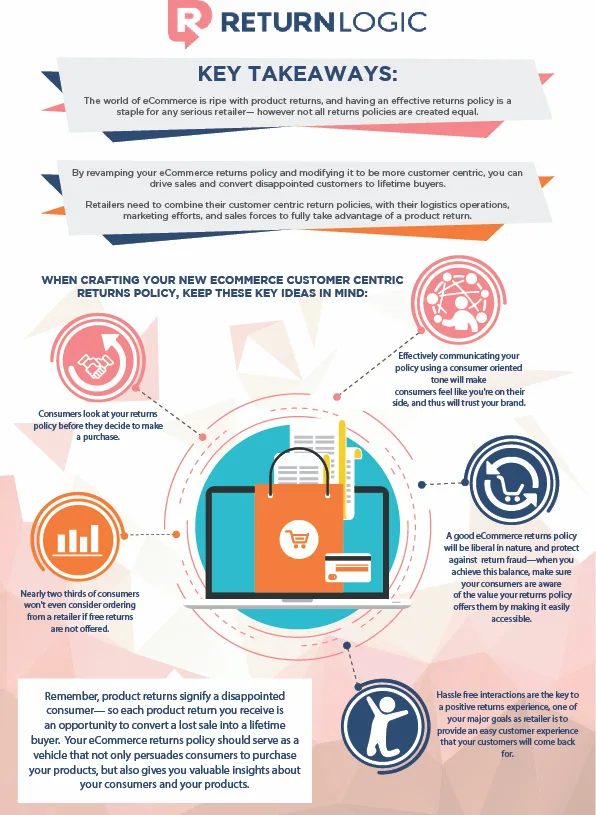
The world of eCommerce is ripe with product returns, and having an effective returns policy is a staple for any serious retailer— however not all returns policies are created equal.
By revamping your eCommerce returns policy and modifying it to be more customer centric, you can drive sales and convert disappointed customers to lifetime buyers.
Retailers need to combine their customer centric return policies, with their logistics operations, marketing efforts, and sales forces to fully take advantage of a product return.
When crafting your new eCommerce customer centric returns policy, keep these key ideas in mind:
- Consumers look at your returns policy before they decide to make a purchase.
- Nearly two thirds of consumers won’t even consider ordering from a retailer if free returns are not offered.
- Effectively communicating your policy using a consumer oriented tone will make consumers feel like you’re on their side, and thus will trust your brand.
- A good eCommerce returns policy will be liberal in nature, and protect against return fraud—when you achieve this balance, make sure your consumers are aware of the value your returns policy offers them by making it easily accessible.
- Hassle free interactions are the key to a positive returns experience, one of your major goals as retailer is to provide an easy customer experience that your customers will come back for.
Remember, product returns signify a disappointed consumer— so each product return you receive is an opportunity to convert a lost sale into a lifetime buyer. Your eCommerce returns policy should serve as a vehicle that not only persuades consumers to purchase your products, but also gives you valuable insights about your consumers and your products.






